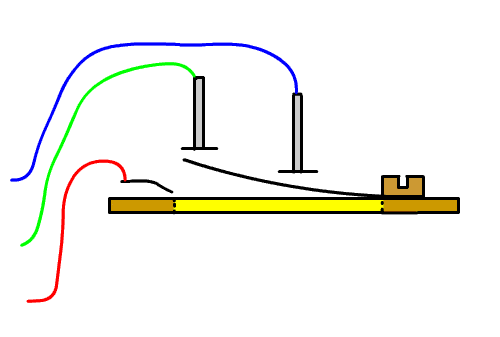Wurlitzer 4600 series
North Suburban Hammond Organ Service
Here is an animation that illustrates a typical three-pickup reed in the Wurlitzer electrostatic organ. The reed vibrates continuously as long as the instrument is powered on. Applying a DC voltage to any of the three electrodes causes a suitable AC voltage audio waveform to develop. The electrodes and the reed together constitute three variable capacitors that share a common plate (the reed). Electrically, however, they represent three separate capacitors.

Figure 3. A typical reed with three pickups. Notice that the time interval for the reed to sweep by the front pickup is very small. resulting in the generation of two sharp spikes in the waveform for each complete cycle of vibration.
Audio signals occur only when voltage is present on one or more pickups. The amplitude or strength of these audio voltages also depends on how high the DC charging voltage is that is applied. If the voltage is suddenly applied, the resulting audio tone begins virtually instantaneously. If the voltage is initially high, and then gradually decreases over time, the tone will likewise begin loudly and then gradually fade out.
If the voltage is high initially and then fairly quickly drops to a slightly lower level, the resulting signal will begin percussively. If the voltage is allowed to rise gradually to some value, the tones begin softly and gradually increase their level.
These properties are all very useful because they allow the musician, via suitable controls in the instrument's keying circuits, to control the envelopes of the instrument's tones to a considerable degree. By allowing the voltage to rise almost, but not quite instantly, to its steady-state value, this feature adds a very smooth and mellow onset to the tones of the instrument. One of the faults of some electronic instruments of this era is their "telegraph-key" tone, where when you push a key, the sound is instantly on, and when you let go, it's instantly off. This instant-on, instant-off effect is completely unnatural in that real (non-electronic) musical instruments don't do that. Even percussive tones such as piano tones or xylophone notes take a slight amount of time to develop, even if less than a millisecond. Likewise, the tones of all instruments do not decay instantly but take at least a few milliseconds to die out completely.
The electrostatic system lends itself to very easy control of the voltages applied to the reed pickups by means of various simple resistor-capacitor networks which control the application of the charging voltage to the various pickups on the reeds. The reeds, by way of their continuous mechanical vibration, are always "on," in the sense that they are ready to create AC waveforms as soon as the DC charging voltage is applied.
Previous Page Page 4. Next page